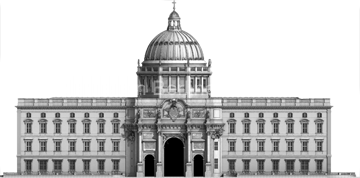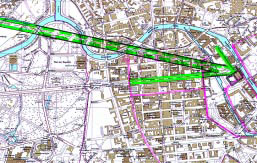The Great Elector Friedrich Wilhelm (1640 – 1688) made the Palace the center of the city and of the country. For 200 years it had stood beside the city as a fortress. The Great Elector drew the city around the west side of the Palace which, until then, had stood free and open. He founded Friedrichswerder, his second wife later founded Dorotheen-stadt and his son, Friedrichstadt.
The area was centralized by the Great Elector, both optically and symbolically, by means of avenues and firebreaks that led to the Palace or, as seen by the prince, that radiated out from him.
Since the time of Pope Sixtus V around 1590, when the Pope placed the obelisk in the Piazza del Popolo in Rome and caused the three streets, Ripetta, Corso and Via del Babuino to radiate from it, three rays have been considered necessary to constitute the full symbolism. The French call this layout the “Patte d’Oie ” or goose’s foot.
The Berlin Patte d’Oie consisted of the center path of the Pleasure Garden (on which today the cathedral strongly encroaches), a path toward the citadel in Spandau (of which the street “Alt-Moabit” remains), and the avenue Unter den Linden. Only the Elector, in his upper room in the Palace could simultaneously see all the rays of the street pattern.
The planner of the Patte d’Oie was Johann Moritz von Nassau-Siegen, a member of the House of Orange, who was a Dutch Field Marshall, and the governor for the Great Elector in Kleve. He was well versed in art and, as an artillery expert, knowledgeable in surveying.
Schlüter built the Knight’s Hall at the exact intersection of rays of the Patte d’Oie for the son of the great elector, King Friedrich I.
King Friedrich I. caused connecting pathways to Charlotten-burg, Oranienburg, and Niederschönhausen to be built, as well as others that have not yet been investigated. Also Friedrich Wilhelm I. had the system further expanded. Incidentally, in the course of the extension, occasionally inaccuracies occurred.
Under the reign of Friedrich Wilhelm I., the old Portal of the Palace in the forecourt (Portal II.) was rebuilt anew. It served as the goal of the Breite Strasse. The great Elector had already had it newly configured in a grand style. Prof. Dr. Goerd Peschken, Berlin
 Deutsch
Deutsch English
English Francais
Francais










